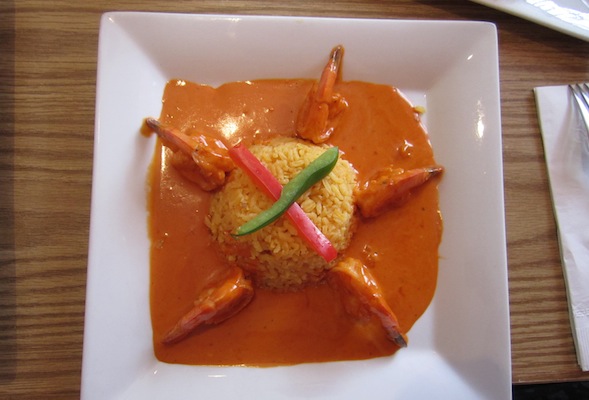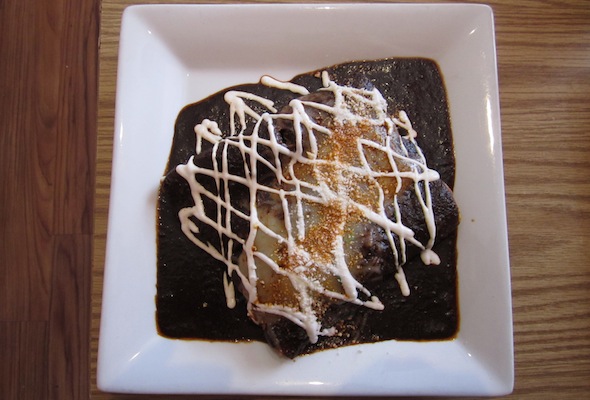A taste of home
Fiesta Poblana is hard to miss, on an otherwise grey block of Corson Avenue in St. George, Staten Island: Its façade is bright orange with touches of pale green, the name of the restaurant in red, curvy letters on a large sign above the door, next to a drawing of a dancer dressed in a rainbow-colored dress and a black sombrero. The menu taped on the front window lists tortas (Mexican sandwiches), tacos, fajitas, fresh guacamole and two items that feature one of the most important elements of the three-year-old restaurant’s menu: enchiladas and chicken with mole poblano. This rich, dark red sauce, which combines spices and cocoa, is in the restaurant’s DNA, and a testament to the authenticity of its food.
Fiesta Poblana is one of 33 Mexican restaurants in Staten Island, at least two-thirds of which opened after 2000, as the borough’s Mexican population boomed. According to the Center for Latin American, Caribbean & Latino Studies at the City University of New York, there were approximately 7,500 Mexican residents of Staten Island in 2000, a number that jumped to more than 16,000 by 2010. In a lecture he gave in April 2013, Dr. Joseph Salvo from the New York City Department of Planning said Staten Island’s Mexican population increased by 154 percent between 2000 and 2010 — more than doubled in just a decade.
On a winter’s Sunday afternoon, Eloy Cardoso lifts the lid of a small heated container in Fiesta Poblana’s kitchen. The mole sits inside, already made, next to its sisters, red sauce and the salsa verde. Cardoso is one of five co-owners of Fiesta Poblana, along with a personal friend and three business partners.
Next to Cardoso in Fiesta Poblana’s kitchen, a young cook stays active at all times, either chopping multi-colored peppers or grilling chicken on a sizzling hot stove. Cardoso taught him to cook. Fiesta Poblana used to have a chef, but now Cardoso is the one who makes the calls in the kitchen. His mole recipe comes from his mother, Mariana, who dictated it on the phone from Chiautla de Tapia, a town at the south of the state of Puebla, in Mexico, where Cardoso grew up before he came to the United States when he was 17.
Beans, chili peppers and corn are the staples of Mexican cuisine. Meat and dairy became part of its repertoire after a wave of Spanish colonization during the sixteenth century. Mole, which brings together European spices with ingredients that used to belong to the New World, such as chocolate and chili peppers, is the definition of a fusion food.
Authentic mole poblano, like the one served at Fiesta Poblana, takes more than four hours, not including prep work, which involves removing the seeds from the peppers, toasting some of the seeds and letting the peppers soften in cold water for at least 30 minutes. Then, those four hours are spent stirring the sauce every couple of minutes with a long, wooden utensil that looks like a paddle, as it cooks down. At the end of the process, after the cook has usually suffered a few burns from splatters of boiling mole, the pot is almost empty, the liquid reduced to a layer of paste remains at the bottom.
To avoid having to repeat that tedious process every day, Cardoso keeps the paste in a transparent container in his walk-in freezer, at the back of the kitchen. One batch usually lasts a week: he adds chicken stock to a little bit of the paste to make a thick, liquid sauce. Next week’s batch is already underway – a chicken carcass is simmering in a large pot on the stove in preparation for future batches of broth.
Cardoso splits his time between Fiesta Poblana and the other business he co-owns, a burger joint named Burger Burger at the southern tip of Manhattan, which has been open for eight years. Alongside a classic cheeseburger and a 6 oz. Angus beef burger, the menu features a Mexican burger with pepper jack cheese, guacamole and jalapeño, and a chipotle burger with chipotle barbecue sauce, pepper jack cheese, onions and grilled jalapeños.

Camarones a la diabla (shrimp in a chipotle sauce) are one of the most popular dishes at Fiesta Poblana. Photo: Clemence Michallon.
Cardoso spends Wednesdays, Saturdays and Sundays at Fiesta Poblana, as well as Thursday and Friday evenings. The rest of the time, he works at Burger Burger, where everything is to go. Cardoso usually stays behind the counter, taking orders from the phone and from walk-in customers. But Fridays are the busiest days of the week at Burger Burger, so Cardoso works in line with the cooks.
“I shouldn’t even pay rent for my apartment!” he says, laughing, in the kitchen of Fiesta Poblana. Cardoso, 38, lives in Borough Park, in the southwestern part of Brooklyn, with his three-year-old son, named Gabriel after Cardoso’s father, and Gigi, the boy’s mother.
Cardoso almost went to culinary school. One of his partners at Burger Burger suggested it, saying the restaurant could pay for tuition. But Cardoso never went through with it.
“I guess I was too lazy, or I thought I was working too much,” he says. “I was interested in business, not in the kitchen.”
Cardoso started off as a dishwasher at Jean-Georges, an upscale French restaurant on Central Park West. After a year, he went to work in another French restaurant called La Folie, since closed, first as a bus boy, then as a food runner. Cardoso’s last long-term job before Burger Burger was at a restaurant called Beckett’s, where he started as a food runner and became a waiter; he was there until it burned down in 2004. He spent two more years running food, until one of his former connections at Beckett’s approached him to discuss a new project that turned into Burger Burger.
Three years ago, Cardoso thought it was time to move up. Fiesta Poblana opened after one of his friends from Staten Island saw that the location was available to lease. The building used to house another Mexican restaurant, a bar where most customers were Mexican. Cardoso and his partners bought the lease. These days, most of the diners are Staten Island locals. On Valentine’s Day night, according to Cardoso, only one out of the restaurant’s 10 tables spoke Spanish.
Suzanne Morelli, a 38-year-old teacher from Staten Island, used to come to Fiesta Poblana every week with her husband, from the other side of the borough. They went there to relive their honeymoon cruise in the Mexican Riviera, in December 2009, which was when Morelli’s husband grew to love the local food.
“My husband was in his glory, tacos every day!” she says.
The frequency of their visits slowed down this past Christmas, after the couple had twins. But one Saturday afternoon in February, Suzanne and her husband returned to Fiesta Poblana with their children. They could have gone to one of the borough’s Tex-Mex places, but “that, we’ve done,” Morelli says.
Cardoso is protective of his mole recipe. Giving it away would be taking the risk of losing business to copycats. Clues can be found across the kitchen – a bag of dark red guajillo chili peppers on a shelf, next to even bigger and darker mulato peppers and a bunch of cinnamon sticks. Cardoso usually buys all of the ingredients himself, by car, during weekly shopping trips that keep him busy for two to three hours every Saturday. Most of the produce comes from Lucero, a wholesale produce market in the Bronx.
Cardoso’s mother would like him to come back to Puebla eventually. She and Cardoso’s father own a large ranch, and they need Cardoso, their only son along with five daughters, to help on the property. He says he might choose to return in the future, but for now, he is focused on Fiesta Poblana. The restaurant seats about 40 people, not including the downstairs area. Cardoso would like to make it look nicer, maybe install a fireplace. But his plans keep getting disrupted, as the space is often booked for private parties, making any construction work impossible.
He is also waiting for a margarita machine. Fiesta Poblana has an extensive margarita menu, and each drink has to be blended by hand. When the machine arrives, the process will become easier. Cardoso plans to send out 1,000 invitations for a margarita party at Fiesta Poblana. Business has picked up for the past few weeks, and Cardoso hopes that faster margarita service will bring in even more customers. Once they try Fiesta Poblana, he believes they will come back.
Tags: enchiladas, Mexican, mole, Staten Island

Your Comments